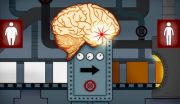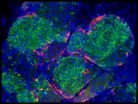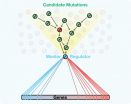(Press-News.org) Oxytocin, the body's natural love potion, helps couples fall in love, makes mothers bond with their babies, and encourages teams to work together. Now new research at Rockefeller University reveals a mechanism by which this prosocial hormone has its effect on interactions between the sexes, at least in certain situations. The key, it turns out, is a newly discovered class of brain cells.
"By identifying a new population of neurons activated by oxytocin, we have uncovered one way this chemical signal influences interactions between male and female mice," says Nathaniel Heintz, James and Marilyn Simons Professor and head of the Laboratory of Molecular Biology.
The findings, published today in Cell (October 9), had their beginnings in a search for a new type of interneuron, a specialized neuron that relays messages to other neurons across relatively short distances. As part of her doctoral thesis, Miho Nakajima began creating profiles of the genes expressed in interneurons using a technique known as translating ribosome affinity purification (TRAP) previously developed by the Heintz lab and Paul Greengard's Laboratory of Molecular and Cellular Neuroscience at Rockefeller. Within some profiles from the outer layer of the brain known as the cortex, she saw an intriguing protein: a receptor that responds to oxytocin.
"This raised the question: What is this small, scattered population of interneurons doing in response to this important signal, oxytocin?" Nakajima says. "Because oxytocin is most involved in social behaviors of females, we decided to focus our experiments on females."
To determine how these neurons, dubbed oxytocin receptor interneurons or OxtrINs, affected behavior when activated by oxytocin, she silenced only this class of interneurons and, in separate experiments, blocked the receptor's ability to detect oxytocin in some females. She then gave them a commonly used social behavior test: Given the choice between exploring a room with a male mouse or a room with an inanimate object – in this case a plastic Lego block – what would they do? Generally, a female mouse will go for the non-stackable choice. Legos just aren't that interesting to rodents. But Nakajima's results were confusing: Sometimes the mice with the silenced OxtrINs showed an abnormally high interest in the Lego, and sometimes they responded normally.
This led her to suspect the influence of the female reproductive cycle. In another round of experiments, she recorded whether the female mice were in estrus, the sexually receptive phase, or diestrus, a period of sexual inactivity. Estrus, it turned out, was key. Female mice in this phase showed an unusual lack of interest in the males when their receptor was inactivated. They mostly just sniffed at the Lego. There was no effect on mice is diestrus, and there was no effect if the male love interest was replaced with a female. When Nakajima tried the same alteration in males, there was also no effect.
"In general, OxtrINs appear to sit silently when not exposed to oxytocin," says Andreas Görlich, a postdoc in the lab who recorded the electrical activity of these neurons with and without the hormone. "The interesting part is that when exposed to oxytocin these neurons fire more frequently in female mice than they do in male mice, possibly reflecting the differences that showed up in the behavioral tests."
"We don't yet understand how, but we think oxytocin prompts mice in estrus to become interested in investigating their potential mates," Nakajima says. "This suggests that the social computation going on in a female mouse's brain differs depending on the stage of her reproductive cycle."
Oxytocin has similar effects for humans as for mice, however, it is not yet clear if the hormone influences the human version of this mouse interaction, or if it works through a similar population of interneurons. The results do, however, help explain how humans, mice and other mammals respond to changing social situations, Heintz says.
"Oxytocin responses have been studied in many parts of the brain, and it is clear that it, or other hormones like it, can impact behavior in different ways, in different contexts and in response to different physiological cues," he says. "In a general sense, this new research helps explain why social behavior depends on context as well as physiology."
INFORMATION:
Researchers at Yale School of Medicine have uncovered a molecular process in the brain known to control eating that transforms white fat into brown fat. This process impacts how much energy we burn and how much weight we can lose. The results are published in the Oct. 9 issue of the journal Cell.
Obesity is a rising global epidemic. Excess fatty tissue is a major risk factor for type 2 diabetes, cardiovascular disease, hypertension, neurological disorders, and cancer. People become overweight and obese when energy intake exceeds energy expenditure, and excess calories ...
Harvard stem cell researchers today announced that they have made a giant leap forward in the quest to find a truly effective treatment for type 1 diabetes, a condition that affects an estimated three million Americans at a cost of about $15 billion annually:
With human embryonic stem cells as a starting point, the scientists are for the first time able to produce, in the kind of massive quantities needed for cell transplantation and pharmaceutical purposes, human insulin-producing beta cells equivalent in most every way to normally functioning beta cells.
Doug Melton, ...
CAMBRIDGE, Mass. (October 9, 2014) – Within almost every human cell is a nucleus six microns in diameter—about one 300th of a human hair's width—that is filled with roughly three meters of DNA. As the instructions for all cell processes, the DNA must be accessible to the cell's transcription machinery yet be compressed tightly enough to fit inside the nucleus. Scientists have long theorized that the way DNA is packaged affects gene expression. Whitehead Institute researchers present the first evidence that DNA scaffolding is responsible for enhancing and ...
BOSTON – The surprising discovery of a previously unidentified class of lipid molecules that enhance insulin sensitivity and blood sugar control offers a promising new avenue for the prevention and treatment of type 2 diabetes.
The new findings, made by a team of scientists from Beth Israel Deaconess Medical Center (BIDMC) and the Salk Institute, are described in the October 9 online issue of the journal Cell.
"We were blown away to discover this completely new class of molecules," says senior author Barbara Kahn, MD, Vice Chair of the Department of Medicine ...
Beer yeasts produce chemicals that mimic the aroma of fruits in order to attract flies that can transport the yeast cells to new niches, report scientists from VIB, KU Leuven and NERF in the reputed journal Cell Reports. Interestingly, these volatile compounds are also essential for the flavor of beverages such as beer and wine.
Kevin Verstrepen (VIB/KU Leuven): "The importance of yeast in beer brewing has long been underestimated. But recent research shows that the choice of a particular yeast strain or variety explains differences in taste between different beers and ...
A key mechanism behind diabetes may start in the brain, with early signs of the disease detectable through rising levels of molecules not previously linked to insulin signaling, according to a study led by researchers at the Icahn School of Medicine at Mount Sinai published today in the journal Cell Metabolism.
Past studies had found that levels of a key set of protein building blocks, branched-chain amino acids (BCAAs), are higher in obese and diabetic patient, and that this rise occurs many years before someone develops diabetes. Why and how BCAA breakdown may be ...
NEW YORK, NY (October 9, 2014)—Using an innovative algorithm that analyzes gene regulatory and signaling networks, Columbia University Medical Center (CUMC) researchers have found that loss of a gene called KLHL9 is the driving force behind the most aggressive form of glioblastoma, the most common form of brain cancer. The CUMC team demonstrated in mice transplants that these tumors can be suppressed by reintroducing KLHL9 protein, offering a possible strategy for treating this lethal disease. The study was published today in the online issue of Cell.
The team used ...
VIDEO:
Salk researchers explain how a new class of lipids may be tied to diabetes.
Click here for more information.
LA JOLLA—Scientists at the Salk Institute and Beth Israel Deaconess Medical Center (BIDMC) in Boston have discovered a new class of molecules—produced in human and mouse fat—that protects against diabetes.
The researchers found that giving this new fat, or lipid, to mice with the equivalent of type 2 diabetes lowered their elevated blood sugar, ...
New Rochelle, NY, October 9, 2014—Excessive and often lethal blood levels of bilirubin can result from mutations in a single gene that are the cause of the metabolic disease known as Crigler-Najjar syndrome type 1 (CNS1). A new gene therapy approach to correcting this metabolic error achieved significant, long-lasting reductions in bilirubin levels in a mouse model of CNS1 and is described in an Open Access article in Human Gene Therapy, a peer-reviewed journal from Mary Ann Liebert, Inc., publishers. The article is available on the Human Gene Therapy website at http://online.liebertpub.com/doi/full/10.1089/hum.2013.233. ...
TIFTON, GA – Weed control is one of the most challenging aspects of organic crop production. Most growers of certified organic crops rely heavily on proven cultural and mechanical weed control methods while limiting the use of approved herbicides. A new study of herbicides derived from clove oil tested the natural products' effectiveness in controlling weeds in Vidalia® sweet onion crops.
"Cultivation with a tine weeder and hand weeding are the primary tools currently used for weed control in organic sweet onion (Allium ceps)," explained scientist W. Carroll ...





